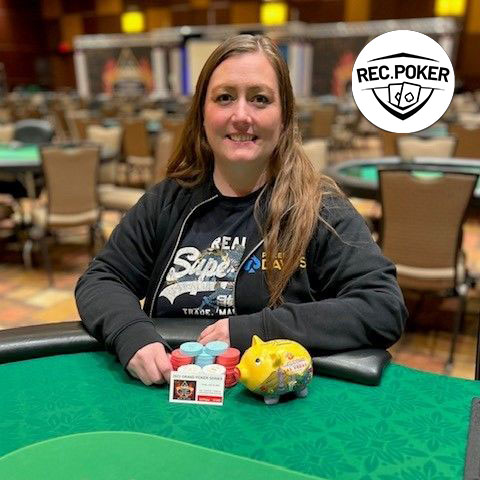The game of No Limit Hold ‘em, and how we learn it, has evolved greatly since the poker boom of the mid 2000s. Long gone are the days of “fold everything against a unicorn except for the top 10 hands”, like when I was learning many moons ago. With a mini-boom happening here in 2020, and many folks playing poker for the first time, accessible instruction for new players needs to be a key component of a training site.
PokerCoaching.com has firmly established itself as one as one of the premier training sites for No Limit Hold ‘em, with a team of outstanding coaches teaching high-level strategy. But along with that, the site is an also outstanding resource for beginners just starting their poker journey!
Jonathan Little has created his 19-module Master the Fundamentals course available FOR FREE(!) for newer players to begin both learning the basics of the game and as an introduction to some higher-level study.
The course begins with the raw basics for the newest of the new, but by the end of this 3-hour+ series of video instruction, you’ll be introduced to many concepts that remain foreign to many small stakes players.
After having taken this course, you’ll have formed the groundwork to become a more than capable poker player and be ready to take the next steps of higher-level courses on PokerCoaching.com to put yourself on the road to becoming a poker crusher!
I created a NEW Course for all of you: Mastering the Fundamentals! In this course, I take you from the rules of the game all the way up to post-flop strategy to help you start your poker journey❤️ PS. It is now completely FREE. Please share!https://t.co/nZzCpNxbXO pic.twitter.com/afpogzhBov
— Jonathan Little (@JonathanLittle) July 10, 2020
PokerCoaching.com Master the Fundamentals: The Rules of No Limit Hold ‘em
For the first couple of videos, you’ll be starting out with the most basic of basics. First up are the rules of no limit hold ‘em, and an explanation of how the game is played.
You’ll be taken through the rounds of betting (pre-flop, flop, turn, river), where you can win at showdown after the cards are all dealt, or by bluffing along the way and making your opponent fold.
A sample hand is played out explaining the purpose of the blinds and the dealer button, and how the action progresses around the table.
Checking, betting, and raising are all explained, along with a brief bit on why you might want to do each on your turn.
Hand Rankings
Along with how to play, knowing what beats what is the other essential basic poker knowledge you’ll need to know.

The rank of hands is presented and explained, followed by a series of showdown examples to determine who the winner is. Using your kicker (side card) to break ‘ties’ is explained, along with a few trickier examples.

Finally, a quick 5 question quiz of which hand wins wraps up the section.
PokerCoaching.com Master the Fundamentals: Effective Stack Size
Unlike some very poorly researched movies, in real poker you can’t pull out your car keys and toss them into a pot. You can only lose the money in front of you. This is known as the ‘effective stack size’.
The practice of thinking of your stack by the number of big blinds you have is introduced, as a better means of determining strategy based on your stack size. Little notes that for most examples throughout the course, a 50 big blind effective stack will be assumed.

You may have 12 million chips in front of you, but if the blinds are 500k/1M, you only have 12 big blinds, and will have to play using a different strategy than if the blinds were much lower.
Pre-flop Strategy: Starting Hands
Now that you’ve begun to properly Master the Fundamentals, the real fun begins. Strategy!
The first video in the pre-flop strategy section provides a look at the types of hands you’ll want to play (hands that can make strong big pairs, straights, flushes and better) and the ones you don’t (ragged offsuit hands).


Some simple strategy is discussed, like why certain hands shrivel in value depending on other action at the table. A hand like ace-ten may look strong, but when there’s a ton of raising and re-raising around you, it’s likely in big trouble and should be folded.
A term you’ll be hearing a lot makes its first appearance: Equity.
Little displays the percentage values of hands (equity) against each other using a program called Equilab, which will be used in greater depth later in the course.

If you’re going to play poker successfully, Little stresses that you must not focus on immediate results, instead remembering that long term is where results will be true. Those ace magnet Kings, or impossible to play pocket Jacks that never seem to win? In the long run, they most certainly will.
Pre-flop Strategy: Three Main Reasons to Bet
A key aspect to good poker and Mastering the Fundamentals in general, is knowing why you’re betting. Little breaks down the three main reasons: for value, for protection, and as a bluff.
When value betting, you want worse hands to call. This can be with a premium hand or a decent but marginal hand you bet for ‘thin value’.
When betting for protection, you want hands that have the potential to improve against you to fold. When you have top pair on a 983 flop, you bet to protect your hand against overcards such as king-jack catching up.
When you bet as a bluff, you’ll be trying to make better hands fold. This can be done as a pure bluff, where you’re always losing if called (usually on the river), or as a semi-bluff, where you apply pressure to a better hand early but you can still improve with a drawing hand.
Pre-flop Strategy: When Everyone Folds to You
Business begins picking up with this video, as the critical concept of thinking in hand ranges is introduced.
You’ll learn to think in terms of a group of hands you might play in a similar way, not just your specific hand. You may hold queen-jack, but you’d also play king-jack, jack-ten, pocket 7s and many other hands in a similar manner. This makes it near impossible for your opponent to know what exact hand you actually have.
Another huge part of learning with PokerCoaching.com is introduced in this section – hand charts.

Little will teach you how to read these charts and use them effectively through the course. He stresses that though you will see a lot of different charts, they won’t need to be memorized. Just the general principles will need to be understood.
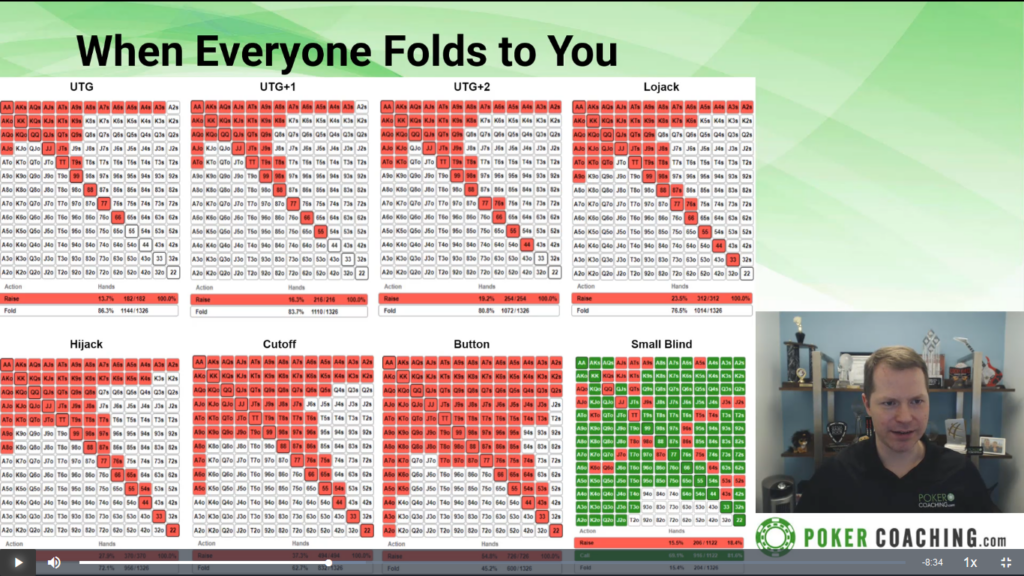
Default 50 BB opening ranges
Along with seeing which hands you should be opening with, Little will teach the importance of raising and not limping, why more hands are playable the later you are in position, and how to adjust your ranges based on your opponents’ tendencies.
Pre-flop Strategy: When You Get 3-bet
Sometimes you’ll be re-raised (3-bet) pre-flop, which can be a scary prospect, but Little will guide you through how to confidently navigate this situation.
There are several things you’ll have to consider including your opponent’s strategy (are they loose or tight?), the amount of the 3-bet (the smaller the bet, the more you should continue), your position (if later, continue more frequently), and your opponent’s position (if you’re in position on them, play more often since you get to act last on subsequent betting rounds).
More charts will be introduced, including what may look like a confusing 4-color chart, but Little will explain how to read it and implement the appropriate play.
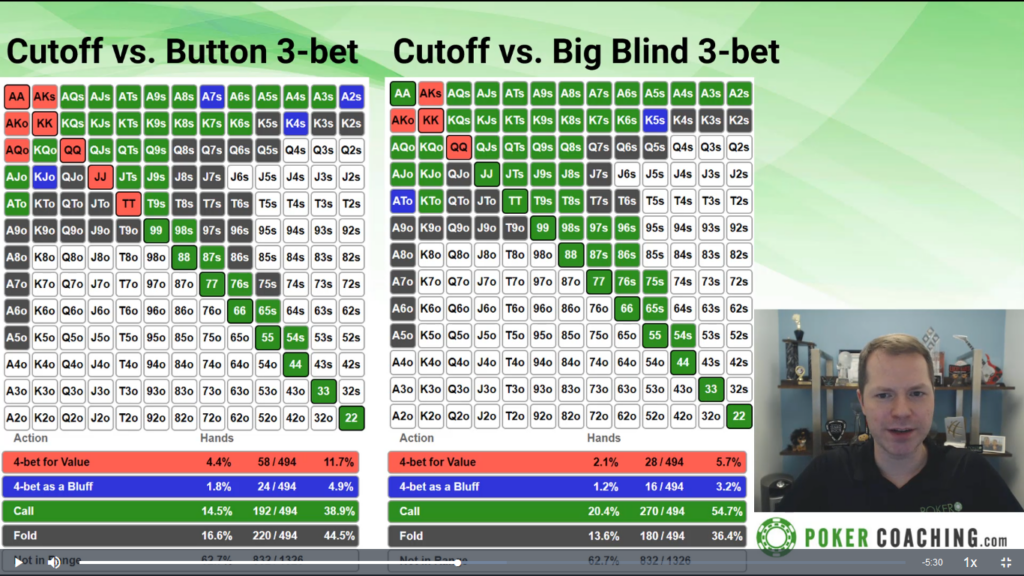
Deeper into range analysis
Pre-flop Strategy: When Facing Limpers
Something you’ll likely be facing a lot when playing small stakes games is opponents limping into the pot (which YOU won’t be doing, right?!).
You’ll learn the difference between tricky limpers (who have some strong hands in their range, hoping to 3-bet a raise), and straightforward limpers (who usually have junky ranges that don’t contain the best hands), and how to play against each with different types of hands.
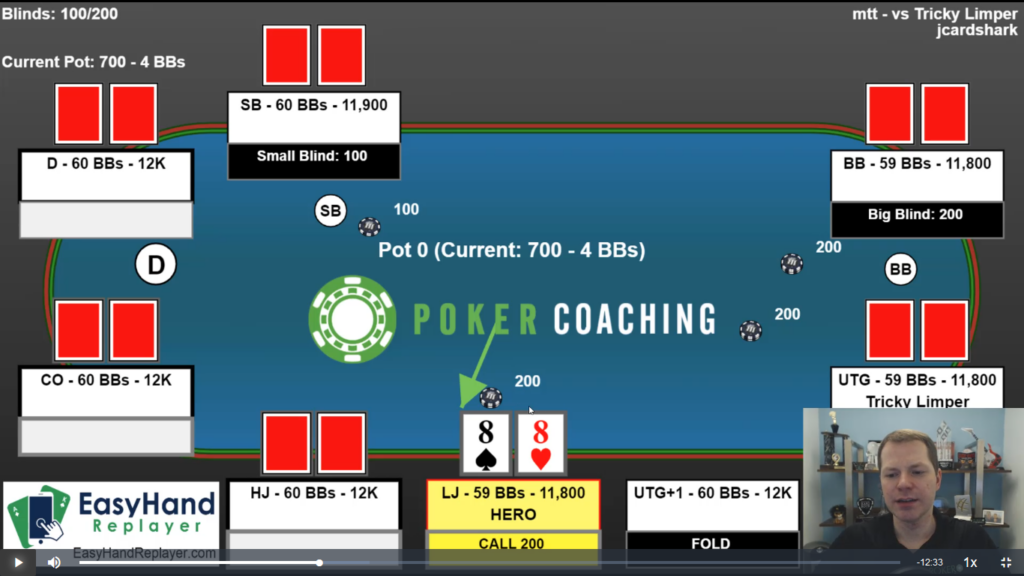
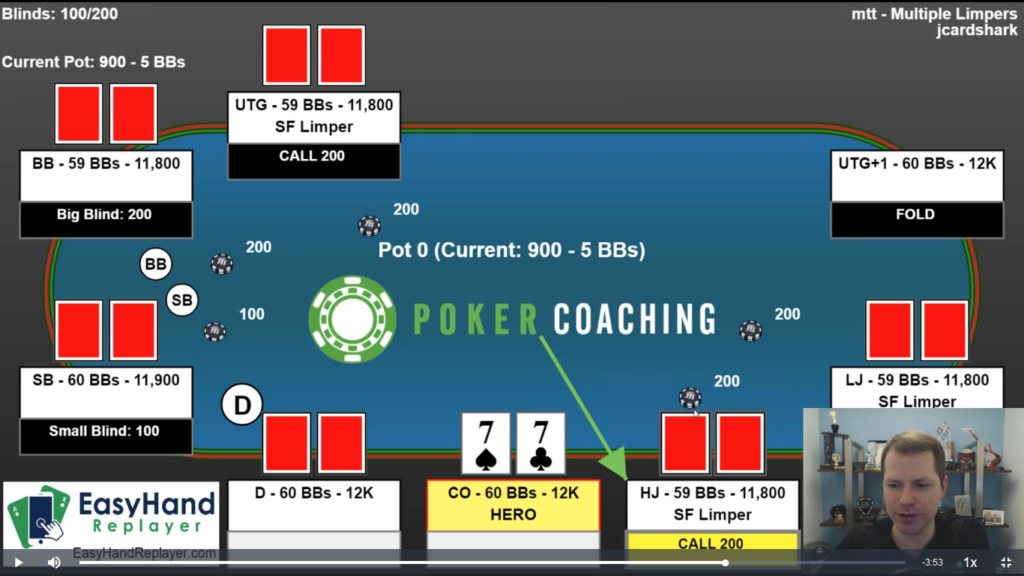
Example A limped in, but should Example B?
The differences between facing one or multiple limpers is discussed as well as how to adjust your raise size accordingly (if you are raising).
Several examples will be provided, including a fun spot where recognizing a weak limping range gives you the green light to bluff with absolute garbage holdings!
Pre-flop Strategy: When Someone Raises Ahead of You
Your opponent’s style is the main focus of this section, as your play will primarily be reactionary to their actions. A key point Little makes is to always think “what does my opponent do wrong, and how can I take advantage of that?”
As such, well known terms such as LAG, TAG, ‘nit’, ‘calling station’, etc, are introduced to describe player types, along with strategies for how to counteract each of them.
Chart work intensifies, with the introduction of polarized, linear, and condensed range composition. Yup, we’re way past the rank of hands now, but don’t be afraid! Everything will be explained well by Little, and you’ll have plenty of time to study and practice the lessons outside the Master the Fundamentals course.
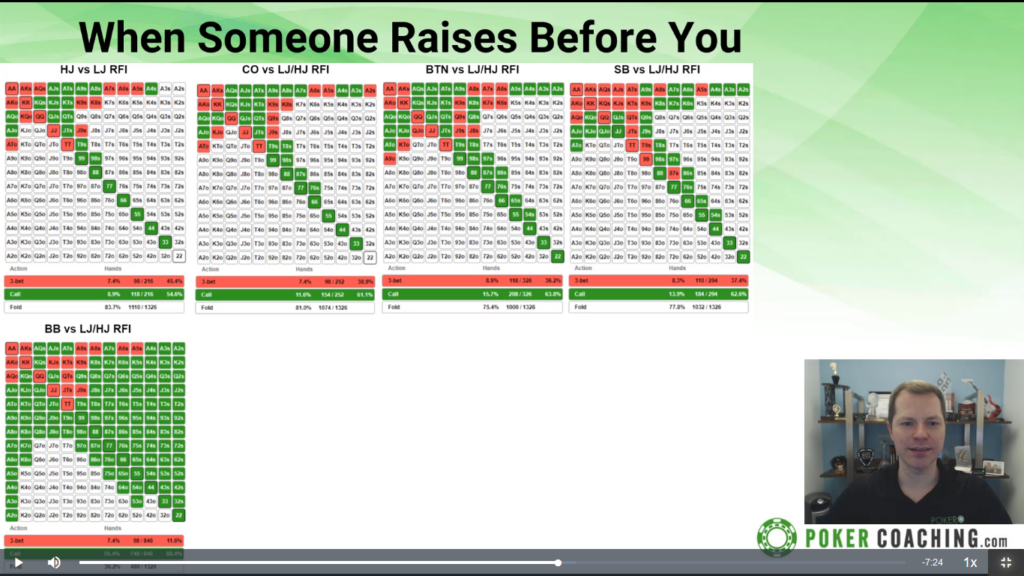
Of note in the charts, Little goes a bit more in depth into small blind play vs. the button, where many players make a lot of mistakes by ‘just calling for a discount’ with all sorts of garbage. He stresses the importance of a 3-bet or fold strategy here.
This section definitely has the most strategy so far, and you should be ready to get a little out of your comfort zone.
Pre-flop Strategy: When There is Lots of Action
We briefly mentioned Equilab earlier, but it gets its first full look in this module as we evaluate hand strengths when things get a little crazy at the table.
Sure, pocket jacks are generally a pretty great hand, but when you’re up against an early position raise and a 3-bet, how great are they now? Little uses Equilab to run the equities of those jacks in a couple of situations, based on position and opponent type.
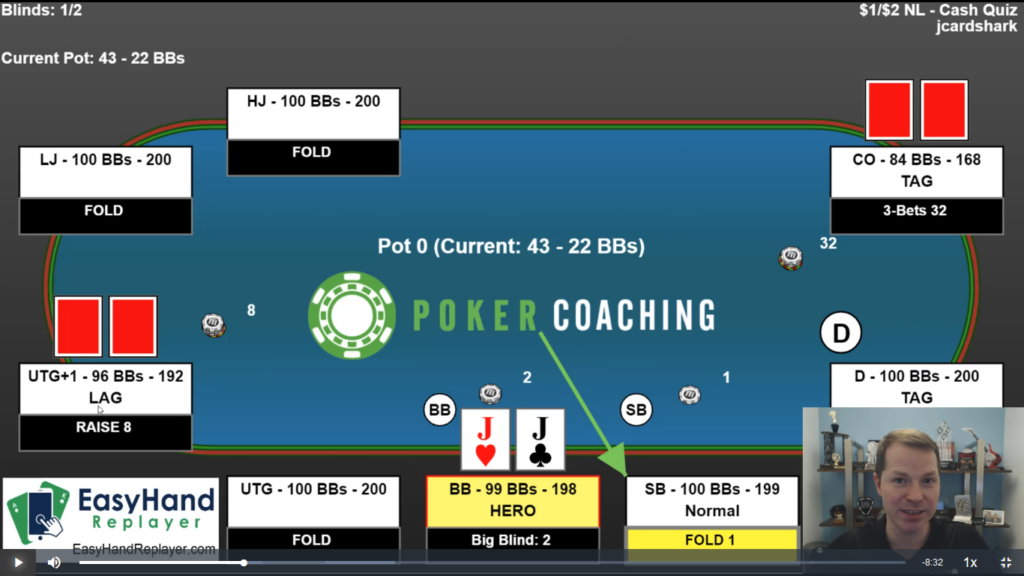
Equilab. Where you’ll see that pocket jacks are actually supposed to win sometimes. Just not this one.
There will be plenty to consider and analyze, but in general, when multiple players are piling money into the pot, you’ll need a very strong hand to play.
PokerCoaching.com Master the Fundamentals: Post-flop Strategy
As we begin the post-flop lessons, a pair of hugely important concepts are introduced: Range advantage and nut advantage.
These will be among your primary considerations when deciding whether to continuation bet on the flop.
Range advantage is a consideration of whose range connects better with the flop, while nut advantage is a consideration of whose hand contains more premium holdings on the flop.
Little uses Equilab again to compare the equity of ranges in under the gun vs. big blind situations with two very different flops (AKQ / 765).
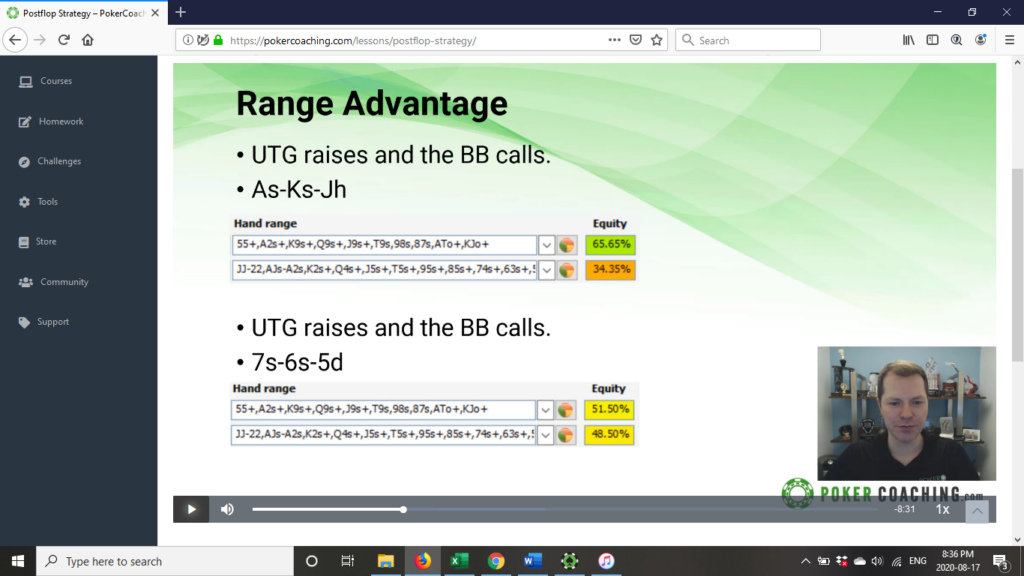
Flop textures impact equities significantly.
Using these examples, we’ll determine who has the range and nut advantages, and which flops you should be betting. *SPOILER: when the flop favors your range, you’re betting. But what if your opponent has the nut advantage? How will that impact your bet frequency and sizing?*
Post-flop: Flop Strategy
Now that we’ve been introduced to the concepts of range advantage, nut advantage, and position, we’ll learn how they impact our post-flop play, specifically on the flop.
Little immediately gets to a huge mistake a lot of new players and amateurs make: only betting when they actually connect with the flop. As we know, when we have the range advantage we can be betting frequently because even if we didn’t connect with the flop with our exact hand, we have that range advantage on our opponent. Little will guide you through bet sizings, based on your opponent’s likely continuing range.
We’ll also discuss how to proceed when you do not have the range advantage as the aggressor in the pot. This gets a little trickier, as you’ll have to break your hand type down to one of four categories and proceed accordingly.
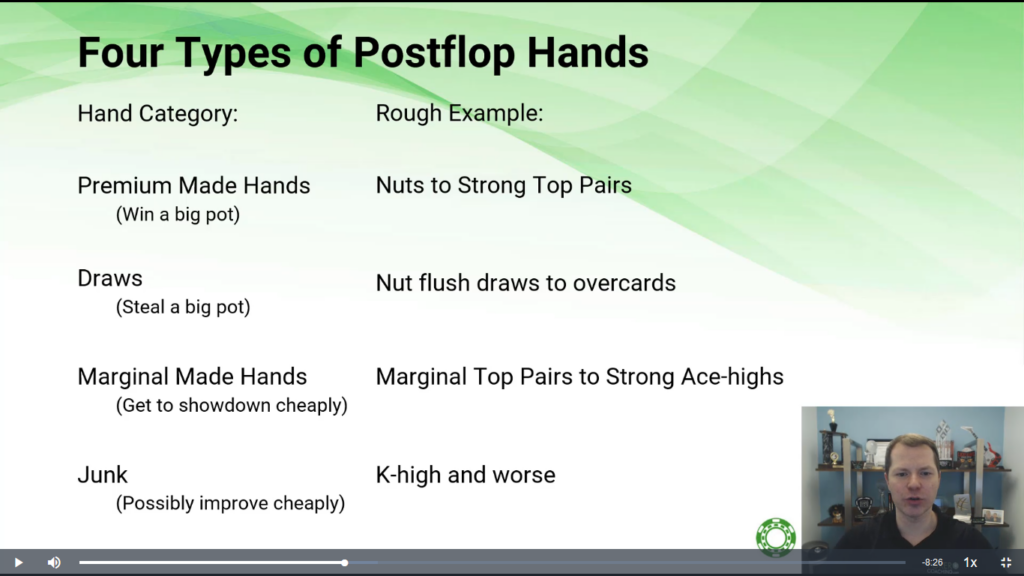
Little breaks down why we want to be applying pressure with premium hands and draws, while playing cautiously with marginal hands and junk.
Finally, we’ll discuss why a small bet size is best when betting frequently, vs. a larger bet size in spots we’re betting infrequently.
Post-flop: Multi-way
As more people see the flop with you, someone is more likely to have a strong hand, and if it isn’t you, well, it’s probably someone else. As such, we need to proceed cautiously.
This short section includes a couple of good examples where strong starting hands like ace-king and pocket 10s must play very carefully with multiple people in the pot.
We’ll flop top pair with the ace-king on a seemingly safe Kc 5h 3h board, but when we bet and get called in two spots, then a third heart falls on the turn, your formerly strong hand has shriveled significantly.
Post-flop: Turn Strategy
This is the longest video of the Master the Fundamentals course at over 30 minutes, but don’t be afraid! It’s heavy on examples, and – as Little explains – the flop and turn are not all that different. Just like on the flop, when you have the range advantage, you want to bet.
The key difference is that while the flop bettor still has their entire range, the caller has folded their garbage on the flop and their range is now stronger. With ranges now closer, the flop bettor will often check the turn.
You’ll go through how to proceed on turns after player actions (bet/call, check/check, check/bet/call) from both coordinated and uncoordinated flops.
There is a lot of analysis in this section. You’ll see spots to represent hands based on turn cards that are good for your range, how you can check the turn to induce river bluffs from opponents’ weakest hands, and how to consider your play if your opponent is capable of check-raising you on the turn.
You’ll also see how to proceed if you get to the turn with multiple opponents still in the pot.
Post-flop: River Strategy
The river. The most unique street in a hand of poker. No more what-ifs. No more potential to improve. Now you either have the best hand or you don’t.
Little will guide you through river bet sizing for premium hands, marginal hands, and bluffs, along with considerations for multi-way action.
What do you do if you’ve bet the river and your opponent suddenly raises you? Sometimes they’ll be bluffing, sometimes they won’t. In a lot of smaller stakes games, players just aren’t capable of making a big river bluff. In others, players live for it! Who are you up against?
If it’s you in the spot where you’ll have to bluff to win the pot, Little provides an example illustrating what you’ll need to recognize to successfully pull it off!
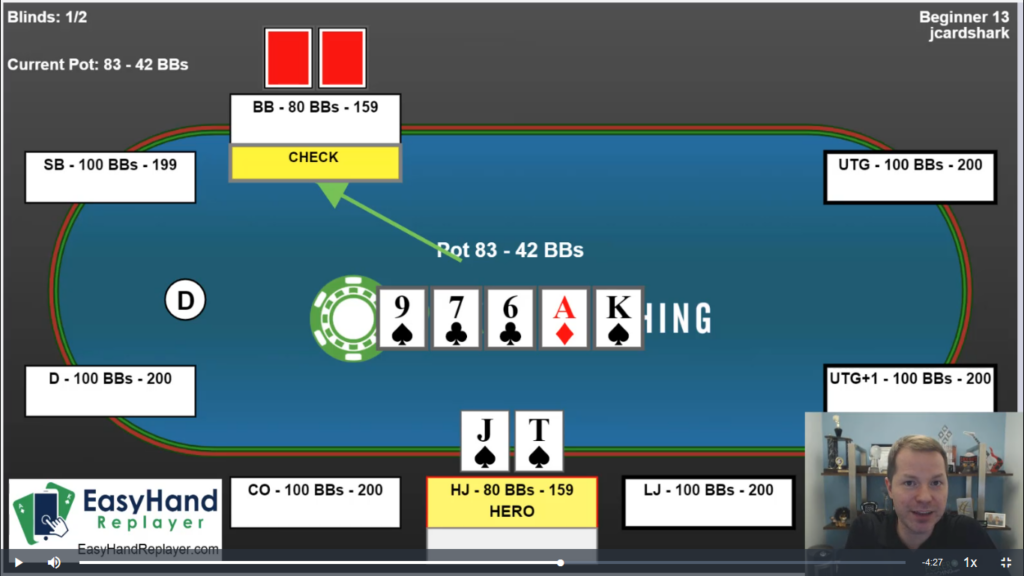
You’re at the river with jack high after betting twice. Should you fire the third bullet?
PokerCoaching.com Master the Fundamentals: Stack Size Adjustments
As mentioned earlier, we’ve gone through this Master the Fundamentals course assuming 50 BB stacks throughout; so what about the many times you won’t be as deep stacked?
Little introduces adjustments and strategies for medium (25-50 BB), short (12-25 BB) and very short (-12 BB) stack sizes.
In general, the shorter you get, the happier you should be to get your money in with top pair type hands. There’s a big difference to getting 30 BB in with top pair as opposed to 200 BB. If somehow you get 200 BB in with just top pair, you’re likely toast.
Speculative starting hands like suited connectors go down in value simply because when you’re shorter, you just can’t win as much money with those type of hands.
As your stack gets shorter, your ability to take flops diminishes and you’ll just have to get it in pre-flop. Little provides a quick tutorial on how to use the PokerCoaching.com push/fold app, which shows the ranges of hands you should be moving all-in with based on your stack size and position.
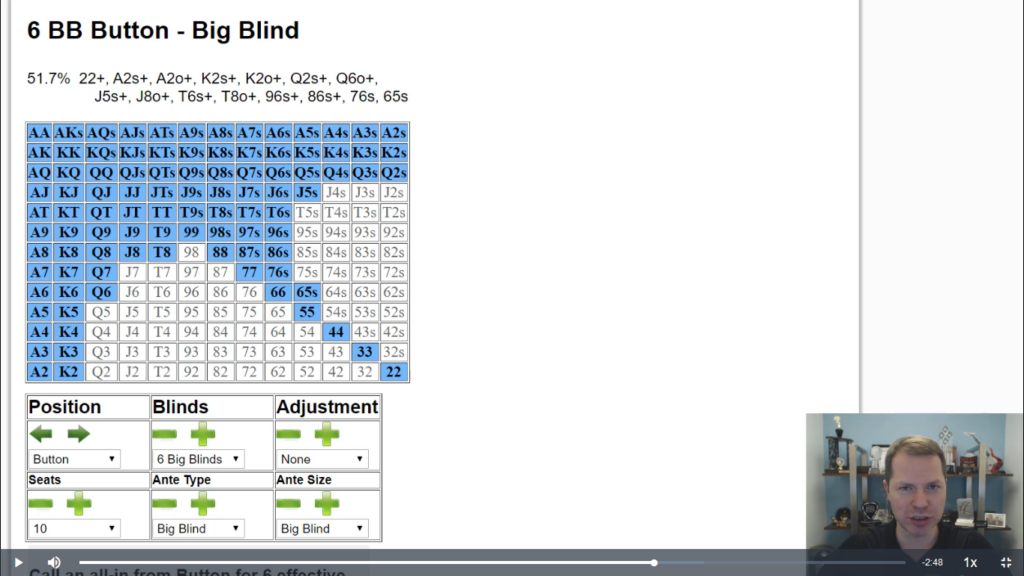
The PokerCoaching push/fold app
Tournament Considerations
Tournaments bring extra considerations if you want to maximize your profit. Little will take you through a typical tournament payout structure and explain that while cashing is important, winning the tournament is far more important.
Basic considerations are provided for when you’re dealing with payout implications in the middle of a tournament, based on stack sizes at your table. If you’re a big stack, pressure everyone! If you’re a middle stack, pressure the short stacks and stay away form the big stacks. If you’re a short stack, get in the money or move up the payout ladder. If you’re THE short stack, you just have to make something happen.
Examples will make these various situations crystal clear.
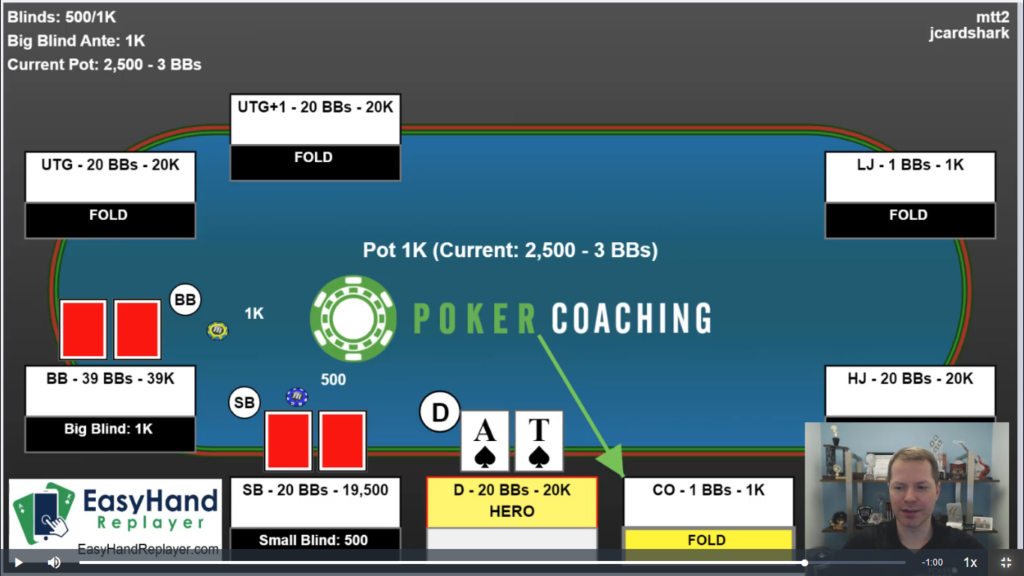
Ace-ten is a very playable hand, especially on the button… but is it here?
*By the way, the letters ICM are not once mentioned yet. That will come in time*
Bankroll Management
As well as you may learn how to play poker, variance is something that will always have an impact on your bankroll. There will be swings, and to be successful, you need to know how to ride them out.
To keep a sustainable cash game bankroll, Little suggests having at least 3,000 big blinds for the level you’re playing. That’s $6,000 for $1/2, or 30 – 100 BB buy-ins.
For tournaments, he suggests having at least 50 buy-ins. So, if you’re playing $100 tourneys, you’ll need $5,000.
Using these guidelines will prevent you from going broke. If you do go through a downswing, you’ll have to move down in stakes. But if you put in the study and work, you’ll be able to move back up quickly.
If your roll swings upward, take a shot at the higher stakes, and if success continues, and you can keep your bankroll within these guidelines, congratulations, you’re moving up!
Continued Learning / Conclusion
Once you’ve made it to the end of the Master the Fundamentals course, congrats! You’re on your way, but the journey is far, FAR from over!
PokerCoaching.com provides many options to study and improve your poker skill set. Quizzes, webinars, courses, homework challenges, and so much more!
Not only can you explore on your own, there are several guided options like this one, including (click each option below for our reviews):
- Cash Game Master Class
- 25K Platinum Coaching Series
- Learning Paths
- 30-Day Tournament Preparation Challenge
Now have fun out there, and good luck in your games!


